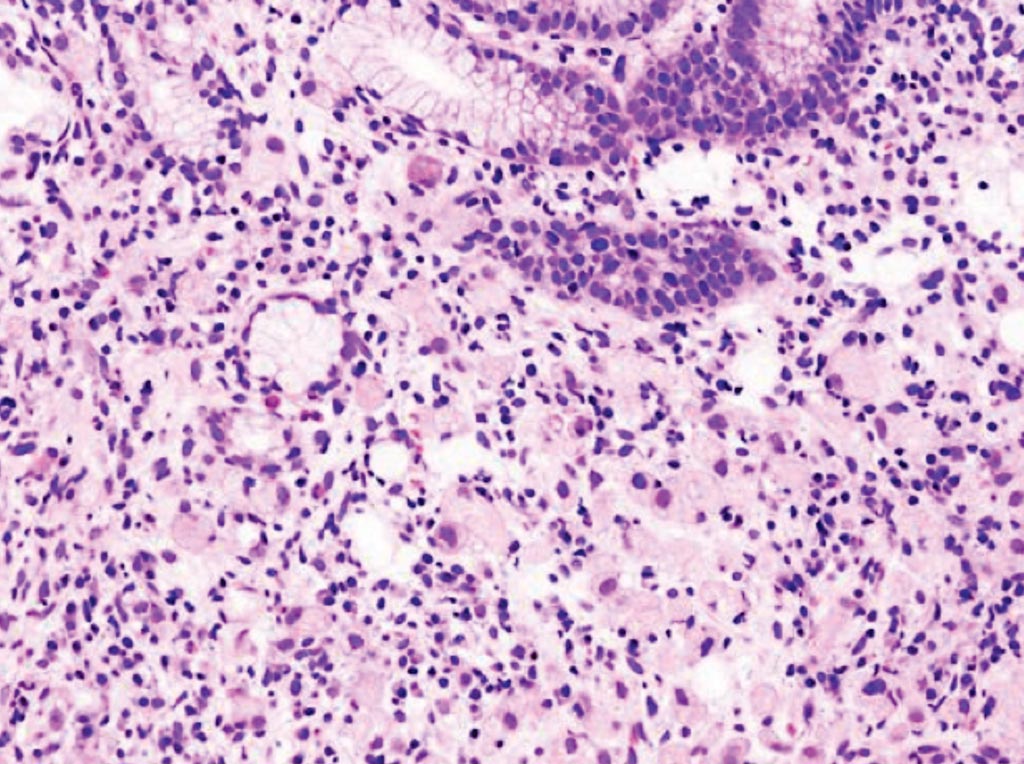Gastric Cancer Analysis Identifies Four Subtypes
By LabMedica International staff writers
Posted on 28 Feb 2019
In previous studies of gastric cancers (GCs), genomic and transcriptomic analyses have identified molecular signatures associated with phenotypes of the disease, such as patient subtypes and survival. New proteogenomic analysis of diffuse gastric cancers (GCs) in young populations identified four subtypes of the disease.Posted on 28 Feb 2019
The Cancer Genome Atlas (TCGA) identified four GC subtypes and associated molecular signatures: Epstein-Barr virus (EBV)-positive tumors with recurrent PIK3CA mutations, DNA hypermethylation, and amplification of JAK2, CD274, and PDCD1LG2; tumors with microsatellite instability with high mutation rates; genomically stable tumors enriched for diffuse histological variants and mutations in RHOA; and tumors with chromosomal instability showing aneuploidy and amplifications of genes encoding receptor tyrosine kinases.

Image: A histopathology of gastric adenocarcinoma representing a signet ring cell variant identified in an endoscopic biopsy specimen (Photo courtesy of KGH).
A large team of scientists collaborating with the Korea University, Seoul, Republic of Korea) collected paired tumor and adjacent normal tissues, as well as blood samples, from 80 patients with early-onset GCs (EOGCs) under 45 years of age. These 80 tumors included 74 diffuse, three intestinal, two mixed types, and one inflammatory myoblastic tumor. For each patient, the team performed exome sequencing of the tumors and peripheral blood mononuclear cells, as well as mRNA sequencing of the paired tumor and adjacent normal tissues.
The team used exome sequencing data, and identified 56,502 non-synonymous single-nucleotide variants and 3,598 frameshift indels. Further, they found 11,938 genes were expressed in the tumor and adjacent normal samples, on average, in the mRNA data. They then used these variants and expressed transcripts from each patient to build a sample-specific database and identified 156,135 peptides, 28,944 phosphopeptides, and 4,376 N-glycopeptides from the global proteomes, phosphoproteomes, and N-glycoproteomes, respectively. These peptides were mapped to 10,295 protein-coding genes, on average.
The scientists compared their own GC subtypes to GC subgroups in TCGA data, and found that subtype 2- and 4-like TCGA subgroups showed the best and worst survivals, respectively. MSI- and EBV-positive GCs were significantly enriched in the subtype 2-like subgroup, while genomically stable GCs were enriched in the subtype 4-like subgroup. They defined subtype 2 as representing immune response-related processes (antigen presentation, BCR/TNF/Toll-like receptor signaling, TCR signaling, and phagosome). Subtype 3 uniquely represented metabolism-related processes (oxidative phosphorylation, fatty acid b-oxidation, and citrate cycle). Subtype 4 mainly represented invasion-related processes (actin cytoskeleton and MAPK, PI3K-AKT, WNT, RHOA, and cadherin signaling).
The authors concluded that based on their data, subtypes 2 and 4 can be characterized as immunogenic and invasive tumors with possibly good and poor survival rates, respectively, similar to subtypes 2- and 4-like subgroups in TCGA cohort. They noted that the tumors in subtype 2 show strong immune activity that may contribute to a good prognosis and that the tumors in subtype 4 show strong invasion potential that may contribute to a poor prognosis. The study was published on January 14, 2019, on the journal Cancer Cell.
Related Links:
Korea University














